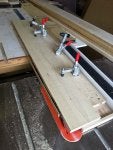I am in the process of making some raised panel doors, drawer fronts and drawers from rough poplar. The finished cabinets are going to be painted.
Well, some of the boards are somewhat crooked. So I came up with this idea which lets me cut the 10 footers into manageable pieces of about 48 inches.
I guess I have been living under a rock and have never seen this in action before but it works great when cross cutting bowed boards. No pinching at all.
I just placed a couple of short pieces of scrap on either side of the saw blade to act as a temporary fence. At this point in the milling process, square isn't important to me. I cut all pieces longer than the final cut anyways.
Then it was on to the table saw. I cobbled up a jointer jig so I could cut a straight side on each board. Again square is not important. The jointer will take care of that later.
I had a piece of 3/4" plywood that I have used in the past as a planer sled and use it on the drum sander for small parts also. I also have a board that I use for clamping purposes when building face frames. So, I combined them to make the table saw jointer sled. Heck I only needed to use two toggle clamps at a time. Since I didn't use any glue, I can remove the pocket screws and return both pieces to their original usefulness.
Ripping a straight edge on bowed boards just became a non tedious task for me. And this is much faster than breaking out the track saw. Also, ripping a straight edge on shorter pieces of stock saves waste vs trying to cut a long straight edge on a bowed board.
This project will have a total of 17 doors and 14 drawers, so I have a pile of wood to go through.
Here are a couple of panels glued up after they had their turn on the jointer.
Hope you find this info helpful.
Mike
Well, some of the boards are somewhat crooked. So I came up with this idea which lets me cut the 10 footers into manageable pieces of about 48 inches.
I guess I have been living under a rock and have never seen this in action before but it works great when cross cutting bowed boards. No pinching at all.
I just placed a couple of short pieces of scrap on either side of the saw blade to act as a temporary fence. At this point in the milling process, square isn't important to me. I cut all pieces longer than the final cut anyways.
Then it was on to the table saw. I cobbled up a jointer jig so I could cut a straight side on each board. Again square is not important. The jointer will take care of that later.
I had a piece of 3/4" plywood that I have used in the past as a planer sled and use it on the drum sander for small parts also. I also have a board that I use for clamping purposes when building face frames. So, I combined them to make the table saw jointer sled. Heck I only needed to use two toggle clamps at a time. Since I didn't use any glue, I can remove the pocket screws and return both pieces to their original usefulness.
Ripping a straight edge on bowed boards just became a non tedious task for me. And this is much faster than breaking out the track saw. Also, ripping a straight edge on shorter pieces of stock saves waste vs trying to cut a long straight edge on a bowed board.
This project will have a total of 17 doors and 14 drawers, so I have a pile of wood to go through.
Here are a couple of panels glued up after they had their turn on the jointer.
Hope you find this info helpful.
Mike








